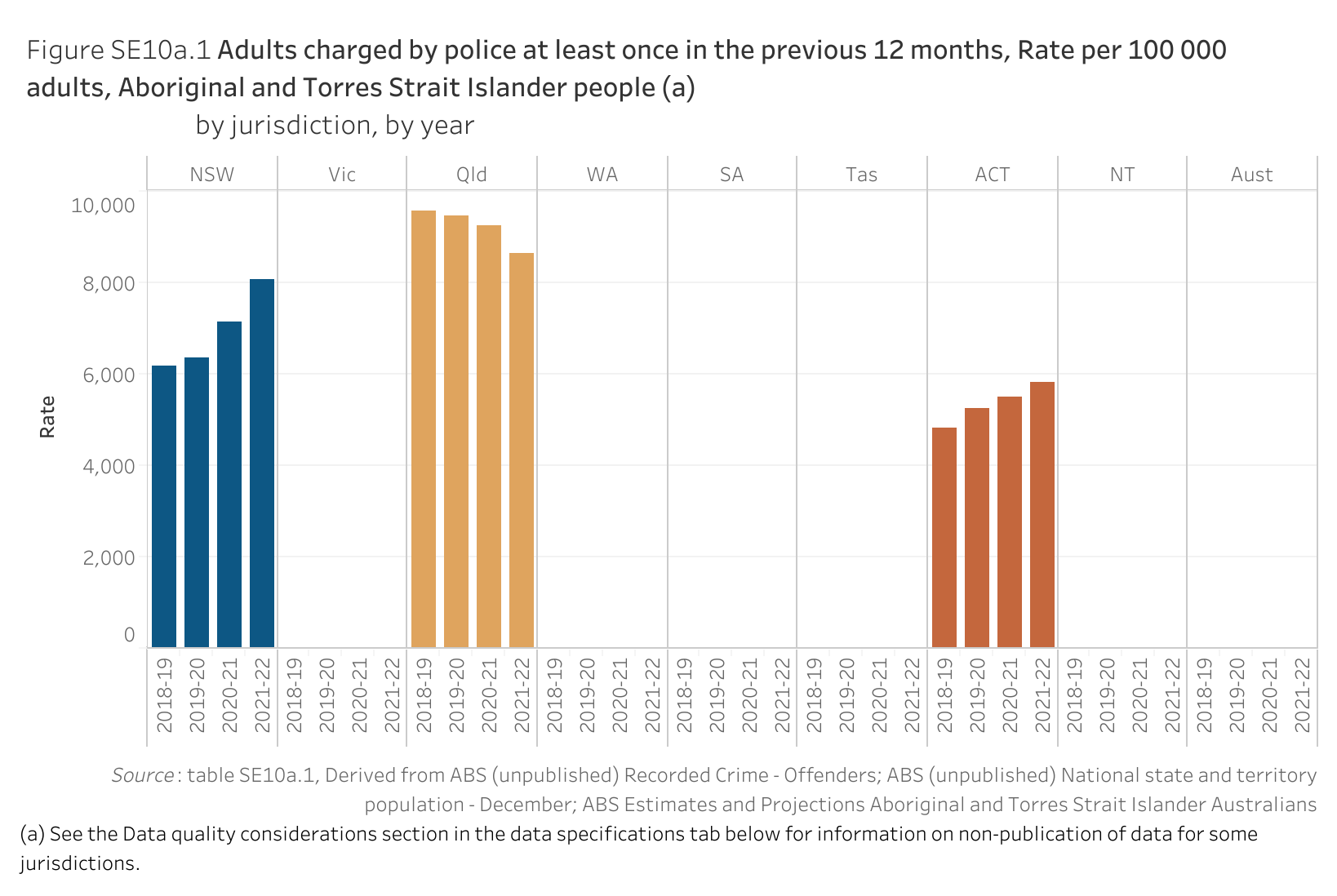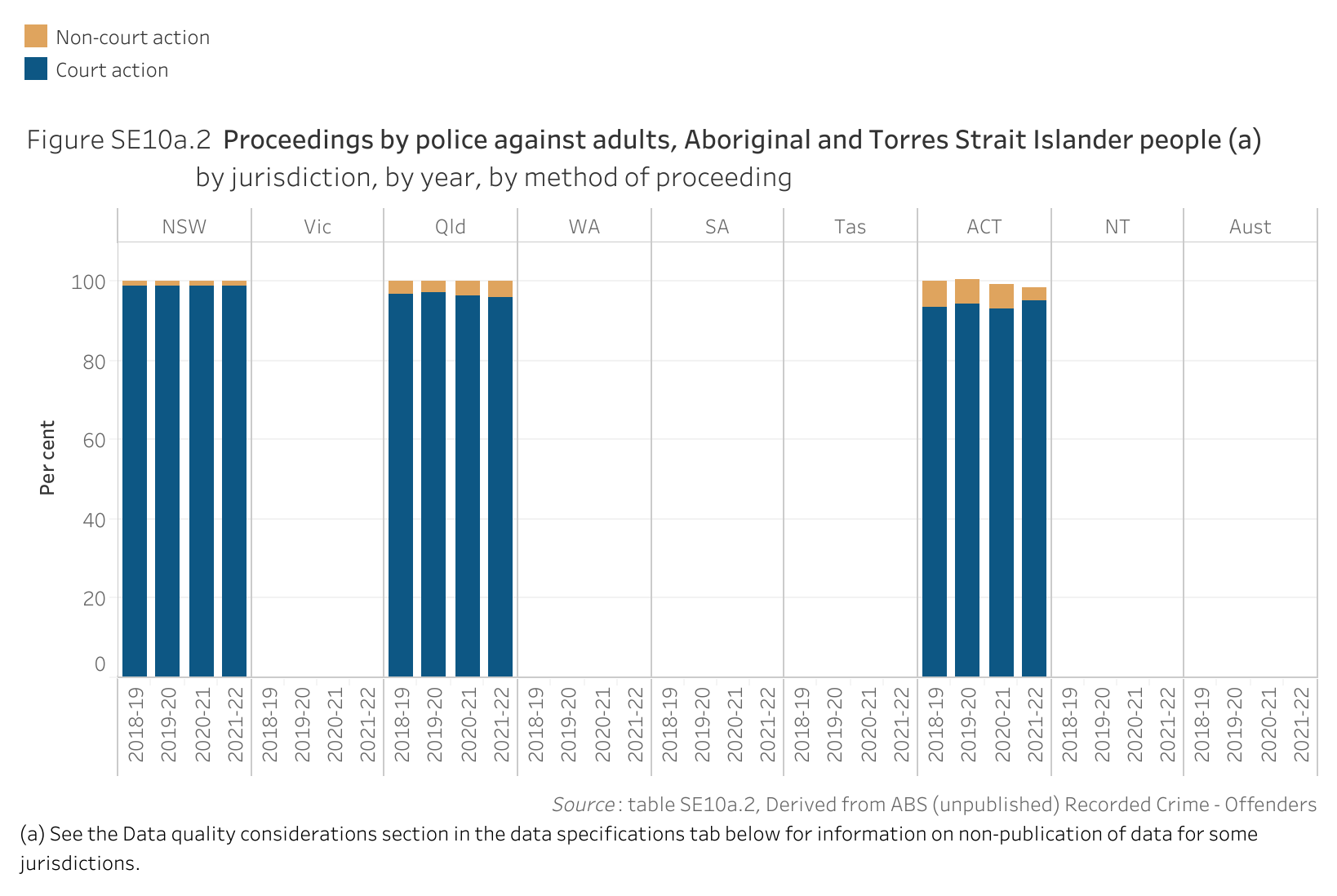Driver
Proportion of Aboriginal and Torres Strait Islander people charged by police
Dashboard snapshot: The data below are the most recent at the time of preparing the July 2023 report. Please go to the dashboard to access the current data.
Measure 1
Rate of adults charged by police
In 2021-22, across the three jurisdictions with available data, the rate of Aboriginal and Torres Strait Islander adults charged by police at least once in the previous 12 months ranged from 5816 per 100 000 adults in the population to 8643 per 100 000.
Since the 2018-19 baseline year, the direction of change for these rates has differed across jurisdictions (figure SE10a.1).

| Year | NSW | Vic | Qld | WA | SA | Tas | ACT | NT | Aust |
|---|---|---|---|---|---|---|---|---|---|
| 2018-19 | 6154.7 | np | 9547.0 | np | np | np | 4816.2 | np | np |
| 2019-20 | 6363.5 | np | 9458.2 | np | np | np | 5249.4 | np | np |
| 2020-21 | 7147.1 | np | 9242.2 | np | np | np | 5487.4 | np | np |
| 2021-22 | 8069.7 | np | 8643.4 | np | np | np | 5816.1 | np | np |
np Not published.
Measure 2
Proportion of police proceedings against adults that are court actions
In 2021-22, across the three jurisdictions with available data, for Aboriginal and Torres Strait Islander adults proceeded against by police, the proportion proceeded against with court actions ranged from 95.1 to 99.0 per cent (with 1.0 to 4.2 per cent proceeded against with non-court actions).
Since the 2018-19 baseline year, the change in proportions between court and non-court action has remained within 2 percentage points for all three jurisdictions (figure SE10a.2).

| Year | Description4 | NSW | Vic | Qld | WA | SA | Tas | ACT | NT | Aust |
|---|---|---|---|---|---|---|---|---|---|---|
| 2018-19 | Non-court action | 1.3 | np | 3.0 | np | np | np | 6.6 | np | np |
| Court action | 98.7 | np | 97.0 | np | np | np | 93.7 | np | np | |
| 2019-20 | Non-court action | 1.2 | np | 2.9 | np | np | np | 6.2 | np | np |
| Court action | 98.8 | np | 97.1 | np | np | np | 94.2 | np | np | |
| 2020-21 | Non-court action | 1.1 | np | 3.6 | np | np | np | 6.3 | np | np |
| Court action | 98.9 | np | 96.4 | np | np | np | 93.0 | np | np | |
| 2021-22 | Non-court action | 1.0 | np | 4.2 | np | np | np | 3.5 | np | np |
| Court action | 99.0 | np | 95.8 | np | np | np | 95.1 | np | np |
np Not published.
Indicator data specifications
Related outcome: | Aboriginal and Torres Strait Islander people are not overrepresented in the criminal justice system. |
|---|---|
Related target: | By 2031, reduce the rate of Aboriginal and Torres Strait Islander adults held in incarceration by at least 15 per cent. |
Indicator: | Proportion of Aboriginal and Torres Strait Islander people charged by police. |
Measure: | There are two measures for this indicator. Measure 1 is the rate of adults charged by police (with one or more court actions), defined as: Numerator — number of Aboriginal and Torres Strait Islander people aged 18 years or over proceeded against by police at least once in the previous 12 months where the principal method of proceeding was a court action Denominator — number of Aboriginal and Torres Strait Islander people aged 18 years or over at 31 December and is presented as a rate per 100 000 people aged 18 years or over. Measure 2 is the proportion of police proceedings against people aged 18 years or over that are court actions, defined as: Numerator — number of police proceedings against Aboriginal and Torres Strait Islander people aged 18 years or over, by method of proceeding (court/non-court action) Denominator — number of police proceedings against Aboriginal and Torres Strait Islander people aged 18 years or over and is presented as a percentage. |
Indicator established: | National Agreement on Closing the Gap July 2020 |
Latest dashboard update for the indicator: | 15 June 2023 |
Indicator type: | Driver |
Interpretation of change: | Measure 1: a low or decreasing rate is desirable. Measure 2: holding the number of proceedings constant, a low or decreasing proportion is desirable. |
Data source(s): | (Measure 2 and numerator for Measure 1) Name: Recorded Crime – Offenders Frequency: Annual Documentation (links): https://www.abs.gov.au/statistics/people/crime-and-justice/recorded-crime-offenders (Denominator for Measure 1) Name: Estimates and projections for Aboriginal and Torres Strait Islander population Frequency: Annual (data revised on a five-yearly basis) |
Data provider: | (Measure 2 and numerator for Measure 1) Provider name: Australian Bureau of Statistics Provider area: National Centre for Crime and Justice Statistics (Denominator for Measure 1) Provider name: Australian Bureau of Statistics Provider area: Demography |
Baseline year: | 2018-19 |
Latest reporting period: | 2021-22 |
Disaggregations: | State and territory and Australia, by Indigenous status. |
Computation: | Measure 1: Numerator divided by Denominator multiplied by 100 000. Measure 2: Numerator divided by Denominator multiplied by 100. Counting rules The reference period is 1 July to 30 June. The reported jurisdiction is the location where the offender was proceeded against by police. Measure 1 ‘People proceeded against by police’ represents a person aged 18 years or over who is proceeded against and recorded by police for one or more criminal offences. An offender is only counted once during the reference period irrespective of the number of offences committed or the number of separate occasions that police proceeded against that offender. ‘Principle method of proceeding’ is defined as the main legal action (court or non-court) initiated by police for an offender based on the ABS hierarchy of method of proceeding classification. A person is counted in the numerator where a least once during the reference period they are recorded:
Denominators (measure 1):
Measure 2 ‘Police proceedings’ represent a count for each separate occasion within the 12‑month reference period that police initiate a legal action against an alleged offender. Court actions by police include the following ABS codes:
Non-court actions by police include the following ABS codes:
Exclusions (all measures): People/proceedings with an unknown or not stated Indigenous status. (Data on the number of people/proceedings whose Indigenous status was not stated is provided for context). |
Data quality considerations: | ABS method of proceeding recorded as court action is used as a proxy for charge for this indicator. Data values have been randomly adjusted using perturbation to avoid the release of confidential data. Discrepancies may occur between sums of the component items and totals. The quality of Aboriginal and Torres Strait Islander identification varies across jurisdictions. Data are only available by Indigenous status for NSW, Queensland, SA the ACT, and the NT. Based on ABS assessment, Indigenous status data for other jurisdictions was not of sufficient quality and/or did not meet ABS standards for self-identification for national reporting. Due to data quality issues, data are not available for method of police proceeding (i.e. court/non-court proceedings) for SA and the NT. Caution should be used when comparing Indigenous status data across states and territories or time periods, due to variations in the proportion of offenders with unknown Indigenous status. |
Future reporting: | Additional disaggregations required for future reporting:
|
